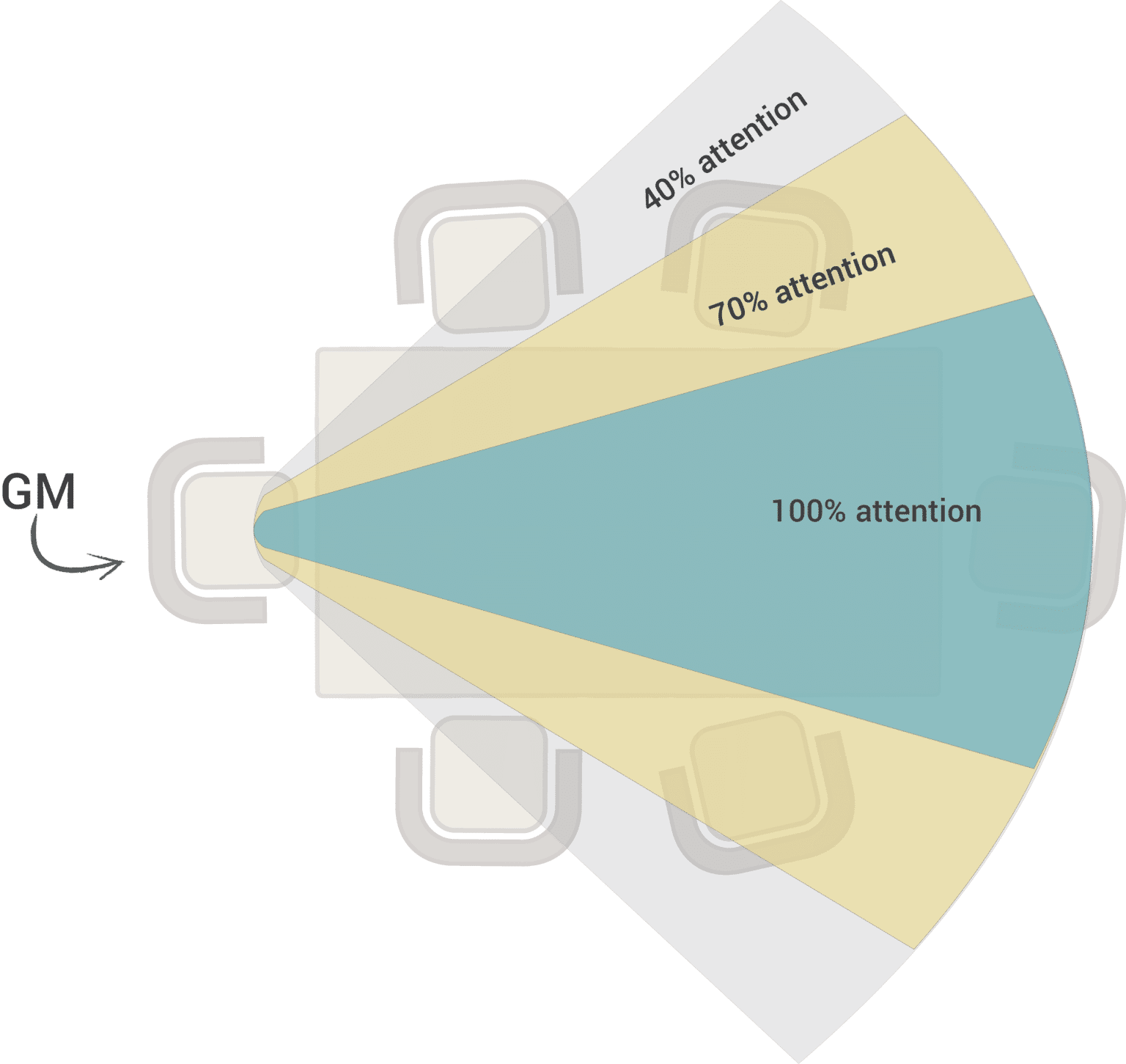Seating Order at the Gaming Table
The best seats get the most attention
“A seating arrangement, really? We’re not at school here.” True, but it’s a helpful trick to make sure every player gets the same amount of attention from the GM. A good seating plan will influence how much each player will be able to contribute to a gaming session. Just google “seating plan meeting,” and you’ll see by the many results, how important this topic is. And the best thing about it is that it’s easy to do and doesn’t take up much time. In this article, we’ll explain how to use a seating plan for your game session.
Impact: ★ ☆ ☆ ☆
Difficulty: Beginner
Time to read: 6 min

Give the best seats to quiet players
Most gaming groups are a mixture of active and passive players. Active players are a gift. With their ideas and actions, they keep the story running. But they usually also demand a lot of attention from the GM. This can cause the quieter players to be overlooked from time to time. In order to avoid this, give the quiet players the best seats within your line of sight. We’re talking about the seats opposite of you, on the other side of the table. This spot will catch your gaze automatically again and again, as the natural posture of the head will guide you there. At this position, it will be easier for you to notice how much your quieter players are participating in the game.
On the contrary, have your noisier or more active players sit directly to your left and right. Turning your attention to these seats is a bit more challenging, as you’ll have to turn your upper body to them. Now, the extent to which you have to turn your head to talk to a player may sound trivial. But during play, these are movements that happen subconsciously. And each additional effort – no matter how small – will have an effect on how much attention you give to your players.
Don’t worry about your active players. Having them sit next to you won’t put them at a disadvantage. Thanks to their proactive playstyle, they’ll attract your attention no matter where they’re sitting.
Separating couples and close friends
Are you often playing with new or changing groups? Then you might want to separate the couples before the game starts to have them not sit next to each other. By “couples” we mean partners in a relationship or best friends – two persons close to each other. Should any in-game conflict arise during a game, these guys will usually team up against the rest of the group. It’s much more interesting if they let go of their real-life companionship for the sake of playing their characters and taking opposite sides during an in-game argument. To encourage this, it really helps not to have them sit next to each other at the gaming table.
Or even better, have them sit opposite each other. From a psychological point of view, this will increase their willingness to argue against each other. Additionally, not being allowed to sit next to their partner or buddy might unsettle them slightly. This could be useful for horror settings.

Imposing a seating order is a psychological trick
Assigning seats to your players is a mean trick to fluster them or get them thinking. Usually no one will object to that. Some might ask, “Hey, why do we have to sit in this order? Is there any effect on the story?” The best way for you to answer is with cryptic sentences like, “You’ll see” or “I’ve got something planned for you”. Don’t give them any specific details on why you do this. As the GM, you can get away with this because as the moderator of the session, you have more authority at the gaming table than the players do.
Now this might sound like a psychological maneuver, but that’s really not the intention here. Instead, it’s about immersion. With some settings, a bit of authority on the side of the GM will make it easier for the players to dive into the mood of your game. A more “stern” gamemaster is great for genres such as horror or dark fantasy. In any case, by telling them where to sit, you’ll have the attention of your players.
Concerning “Using authority as a GM tool,” there’ll be another article in the future.
Breaking up an established seating order
Here’s another clever trick to unnerve your players or get them thinking: break up an established seating order yourself. Leave your position behind the GM screen and stand or sit close to one of them. We’re all used to the GM always sitting neatly behind his gamemaster screen, at a safe distance to the players. Don’t do that. Instead, be bold and break with this tradition. Then the whole room will be your stage, instead of only the spot behind your GM-screen.
Squat insidiously between the players while they make a sneak role to bypass the city guards. Stand behind them, while you reprimand them in the role of a stern teacher or superior. Or snatch their character sheet from the table while you are portraying a border patrol guard checking their documents.
You’ll see that standing close to your players instead of behind the GM screen can unsettle them quite a bit. This effect is coming from intruding on the personal space of others. It has always worked for me so far. But don’t do this more than twice per game session. Otherwise, the effect will diminish quickly.

Further Reading
Here are a few links for the “psychological effect of seating arrangements,” in case you want to delve deeper into this topic. For example, some of these articles explain the concept of the “power seat,” which is the seat of the most important person in the room.
Summary: The impact of who sits where
The seating order is a largely underestimated aspect of most gaming sessions. If done well, you can easily assign more time in the spotlight to the quiet players in your group, to have them contribute more to your story. Additionally, try to break up an established seating order by deliberately leaving your GM seat during the game. This will have an interesting effect on the game. Don’t just accept any given seating order – play around with it and use it as a tool for improving your game’s atmosphere.



